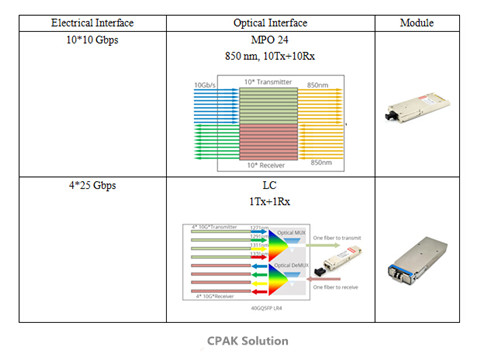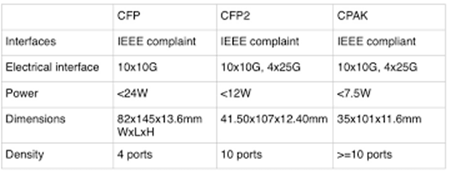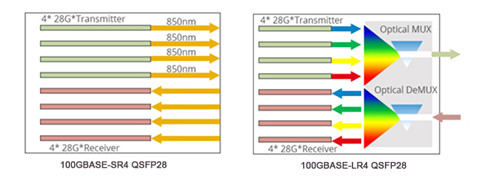100G QSFP28 and CFP optical transceivers as the main transmission media of 100G network, dominate 100G hardware market. CPAK, launched right after CFP2 100G modules, is the Cisco proprietary form factor. Since its certification, CPAk was considered as the alternative of CFP form factor modules. Today's article will describe CPAK 100G module in detail and compare it with other 100G modules such as CFP, CFP2, CFP4 and QSFP28 modules.
What is CPAK Optical Transceiver Module?
Designed as a smaller, low-cost alternative to CFP transceiver, CPAK 100GBASE optical module is not popular on the 100G market nowadays. CPAK module is also the first 100G optical transceiver that uses CMOS Photonics technology. This type of 100GBASE module can work in the following Cisco networking equipment—ASR 9000 Series Router; CRS-X Carrier Routing System; NCS 2000, 4000, and 6000 Series Routers; the Nexus 7000 and 7700 Series Switches, and the Cisco ONS Transport Platform.

CPAK optical transceiver incorporates IEEE standard interfaces available in several different standards: 100GBASE-SR10, 100GBASE-ER4L, 100GBASE-LR4, 10x10G-ERL, 10x10GBASE-LR, etc. CPAK transceivers can support 10X10Gbps and 4X25Gbps mode for an aggregate of 100Gbps data rate (seen in the above image). It can operate high-density 10G breakout with MPO-24 cables, CPAK-100G-SR10 is operating in this type, which is also backward compatible with 10GBASE-SR. CPAK LR4 module is compatible with other 100GBASE-LR4 compliant modules such as CFP to support high-bandwidth 100Gb optical links over standard single-mode fiber terminated with SC connectors.
The main features of CPAK modules are backward compatibility, smaller form factor and energy efficiency.
CPAK Vs. CFP/CFP2/CFP4
As noted before, CPAK was released right after CFP modules. Although CFP is the pioneer in 100G optics, but its big size can not meet the demands of high-density data center. Therefore, CFP2 and CFP4 with more compact sizes are developed. When comparing CPAK with CFP modules, CPAK transceivers are less than one third the size of CFP modules, and dissipate less than one third the power. In a comparison with CFP2 modules, CPAK optical transceivers are 20% smaller and consume 40% less power. In other word, if you use CPAK other than CFP2 modules in your data center switches, it can offer 20% greater port density and front-panel bandwidth.

In short, CPAK optical module has smaller footprint than CXP, CFP and CFP2, but bigger than CFP4 and QSFP28 optics. Besides, CPAK 100GBASE-LR4 consumes less than 5.5W, which is less than CFP LR4 (24W), CFP2 LR4 (12W), CFP4 (9W) and CXP LR4 optics (6W) but a little higher than QSFP28 (3.5W). CPAK represents a significant advancement in optical networking, providing dramatic space and power efficiency.
CPAK Vs. QSFP28
QSFP28 optical transceiver, due to its smallest form factor and lowest power consumption, is regarded as the most promising 100G optical module. In terms of the form factor, QSFP28 is more compact then CPAk modules. As to the power consumption, Cisco CPAK 100GBASE-LR4 module supports link lengths of up to 10 km over standard single-mode fiber with SC connector with a nominal power consumption of less than 5.5W. QSFP28 100GBASE-LR4 supports up to 10km and consumes nearly 3.5W.
QSFP28 transceiver is designed for 100G speeds and using the 4×25 wiring specification. 100G QSFP28 SR4 is designed for short-haul transmission and QSFP28 LR4 is designed for long-haul transmission.

Summary
In 2017, 100G technology and relevant optical transceivers gradually become matured. 100G optics like CXP, CFP/CFP2/CFP4, 100G QSFP28 in different standards offers a huge selection for customers. CPAK module was launched just days after the certification of CFP2 optics. It is popular for the smaller footprint and energy economy. However, when competing with open source MSA compatible 100G products (CFP/CFP2/CFP4 and QSFP28), CPAK is not the ideal one for 100G high-density connectivity. However, many third party optical solution vendors like FS.COM announce to help market to cut down this pricing and save budgets for customers.
评论
发表评论